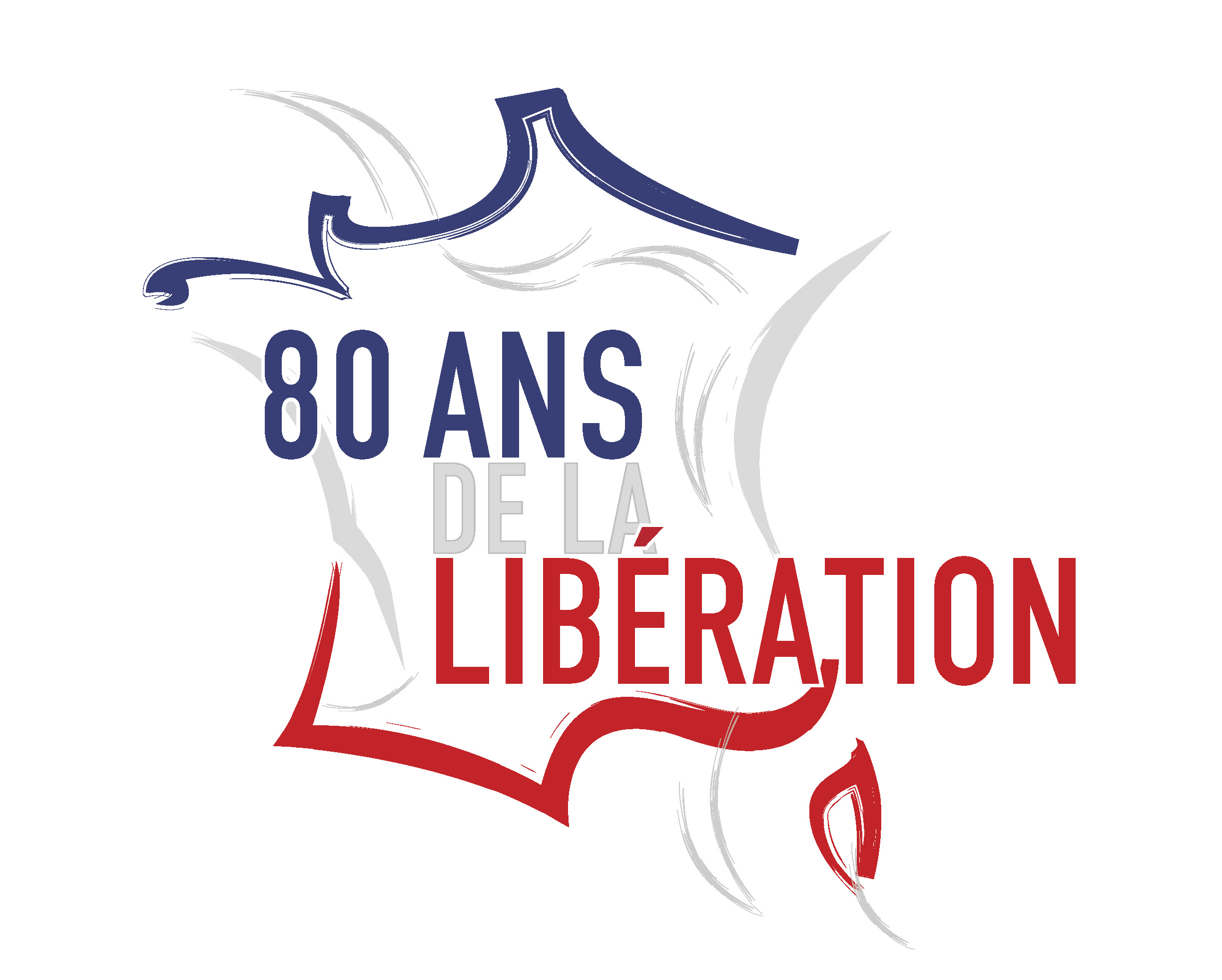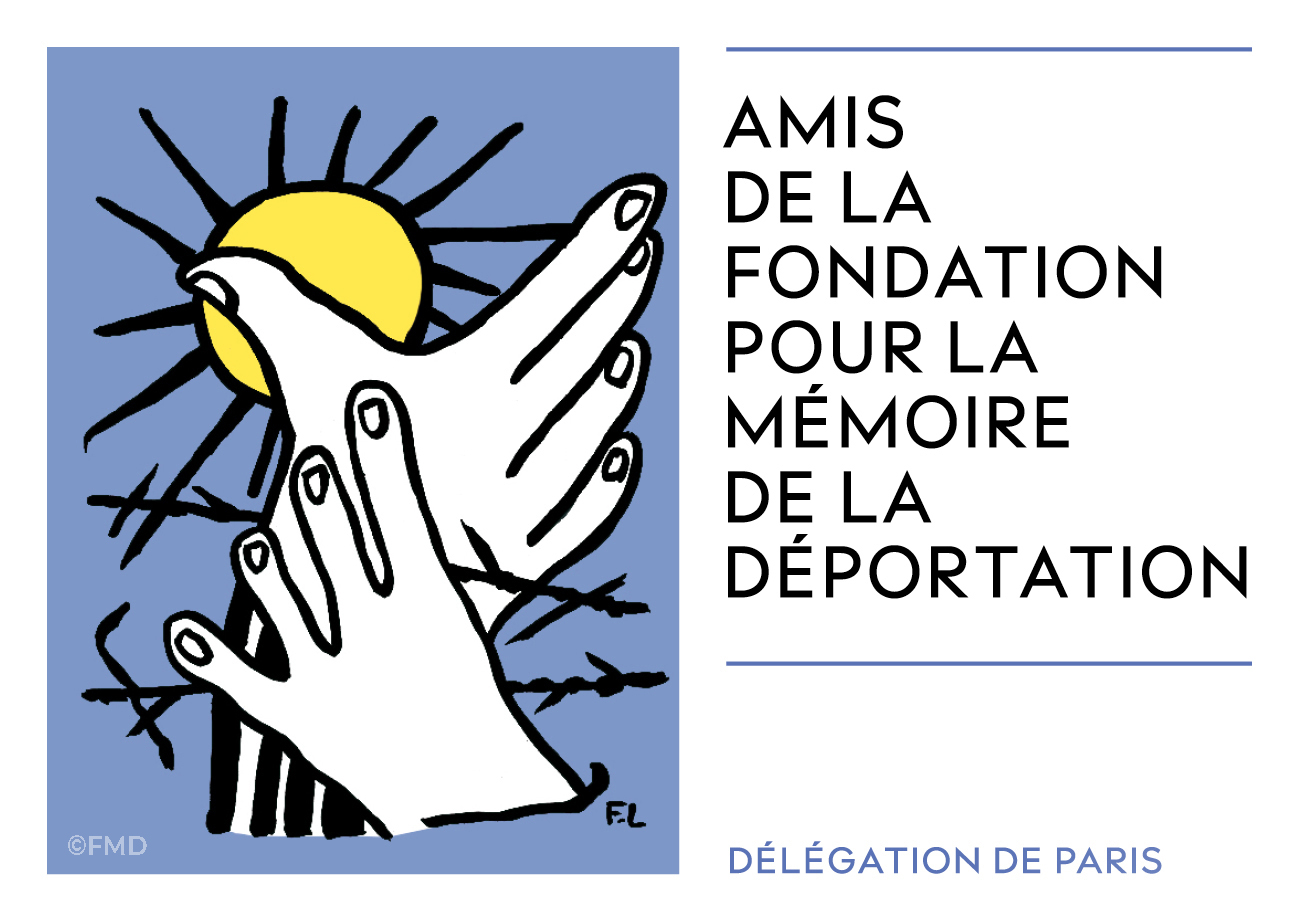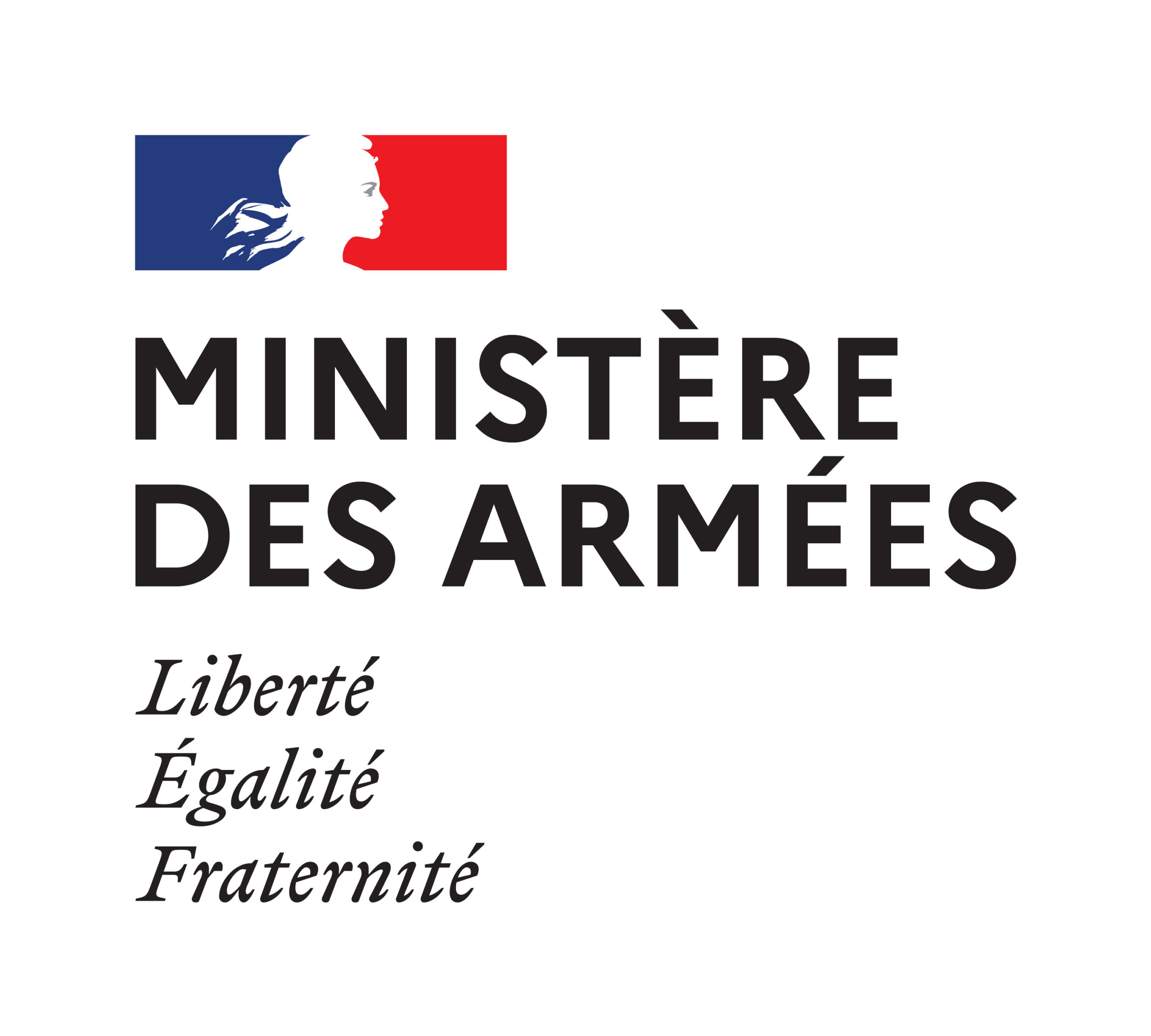BUCHENWALD
Opened in 1937
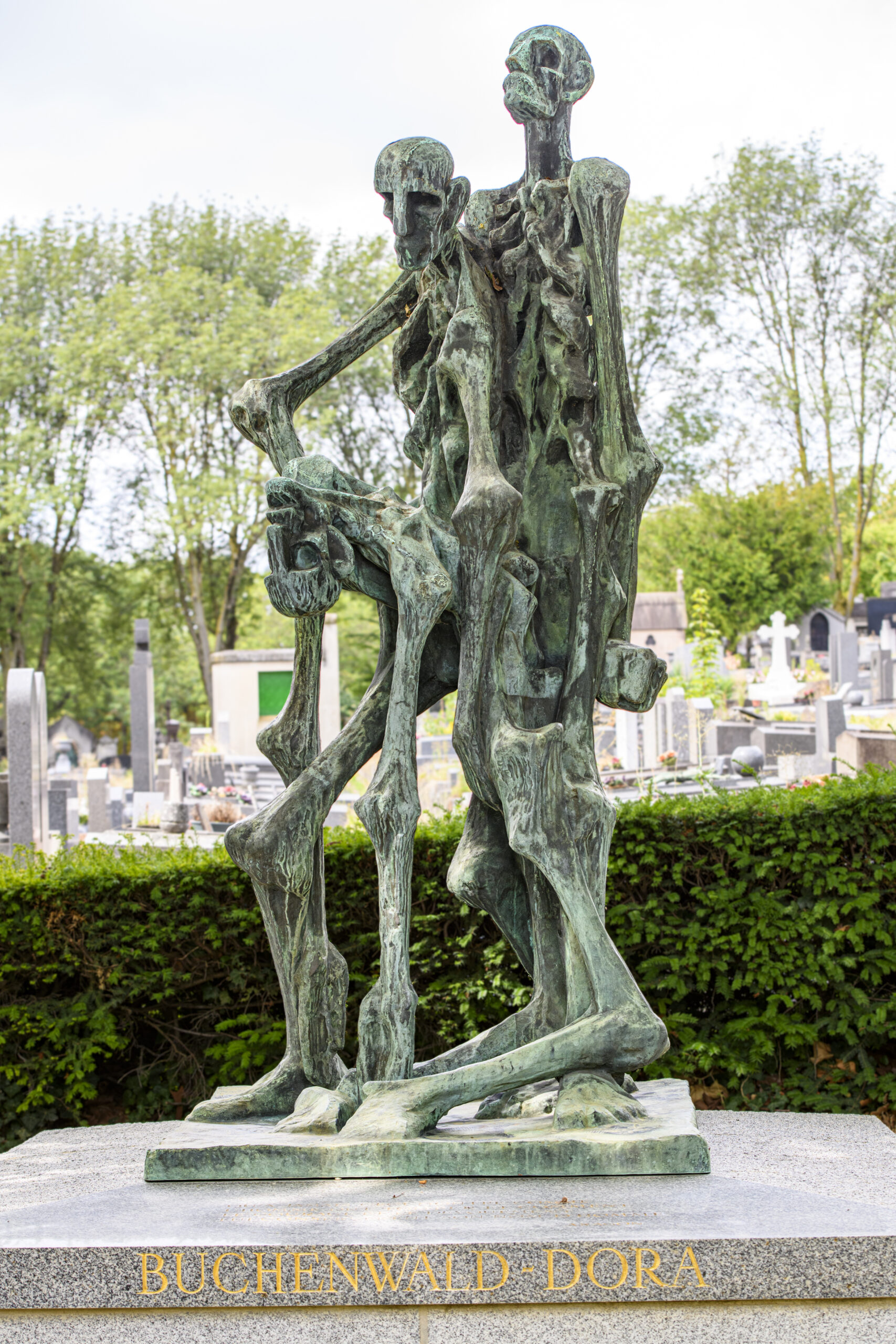
© Vincent Gerbet
Monument’s description
Inaugurated on April 5, 1964, the bronze sculpture by Louis Bancel (Vercors resistance fighter), installed on a granite slab by architect M. Romer (Buchenwald survivor), features a group of three deportees. The emaciation of the three men testifies to the physical decline of the concentration camp system. The attitude of each of the deportees evokes a precise symbolism: suffering (man upside down, frozen in death, hand hanging down), solidarity (man supporting his companion), resistance and dignity (man standing up to his executioners, head proudly raised towards the future).
On the edge of the slab is engraved: Buchenwald-Dora. And on the slab:
May this forever show how
Man had to fall and how
Courage and devotion
preserve his name of Man.
Louis Aragon
Poet Louis Aragon’s quatrain underlines the courage in martyrdom of all those who, with dignity, opposed the dehumanization of Nazi ideology.
Buchenwald camp
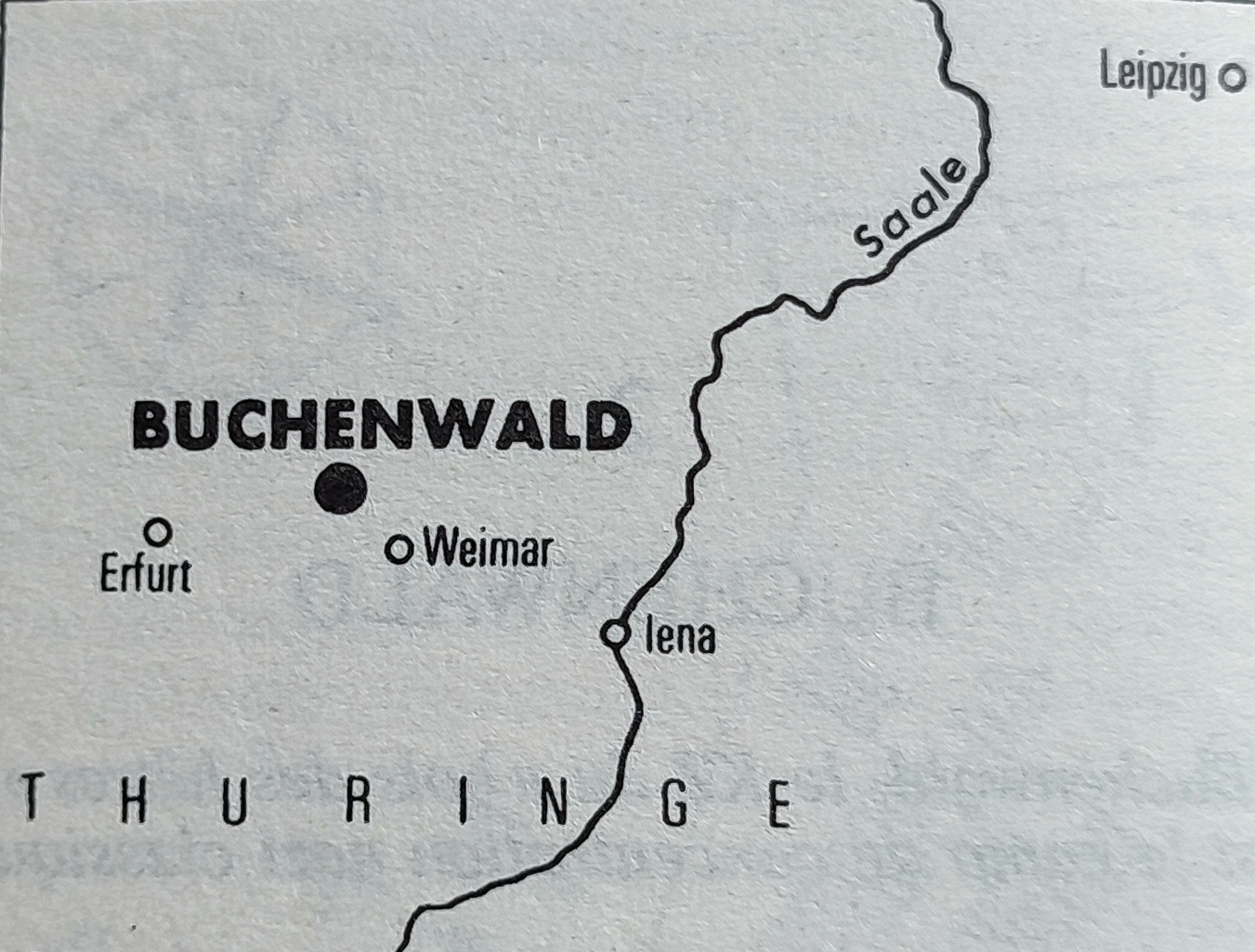
© FNDIRP
In 1937, it was decided to build the Buchenwald camp on the wooded Ettersberg hill in Thuringia, 10 km from Weimar, a city famous for its cultural influence (Goethe, Schiller, Bach) and for having given its name to the Weimar Republic from 1918 to 1933.
The aim was to provide manpower for the industries of central Germany.
Common law prisoners from Sachsenhausen, Lichtenburg and Sachsenburg, known as « green triangles », cleared the Buchenwald hill (meaning « beech forest »), sparing the large oak under whose shade, according to legend, Goethe would go to rest with his secretary.
Everything was created: earthworks, electrification, water supply, roads and a railway station. A nearby quarry facilitated logistics. The inscription JEDEM DAS SEINE « To each his own » hangs over the entrance gate.

©AFMD 75
The camp comprises three areas:
– one reserved for prisoners (roll-call area, prisoners’ blocks, canteen, Revier… but also a « station » for medical experiments, executions and crematoria built in 1941.
– one reserved for the SS (Kommandur, administration, 18 barracks, officers’ residential quarters, military hospital, zoo, stables, farm, library),
– another for factories and workshops: the D.A.W. (Deutsche Ausrüstungs Werke) and the Gustloff Werke arms factory.
Translated with DeepL.com (free version)
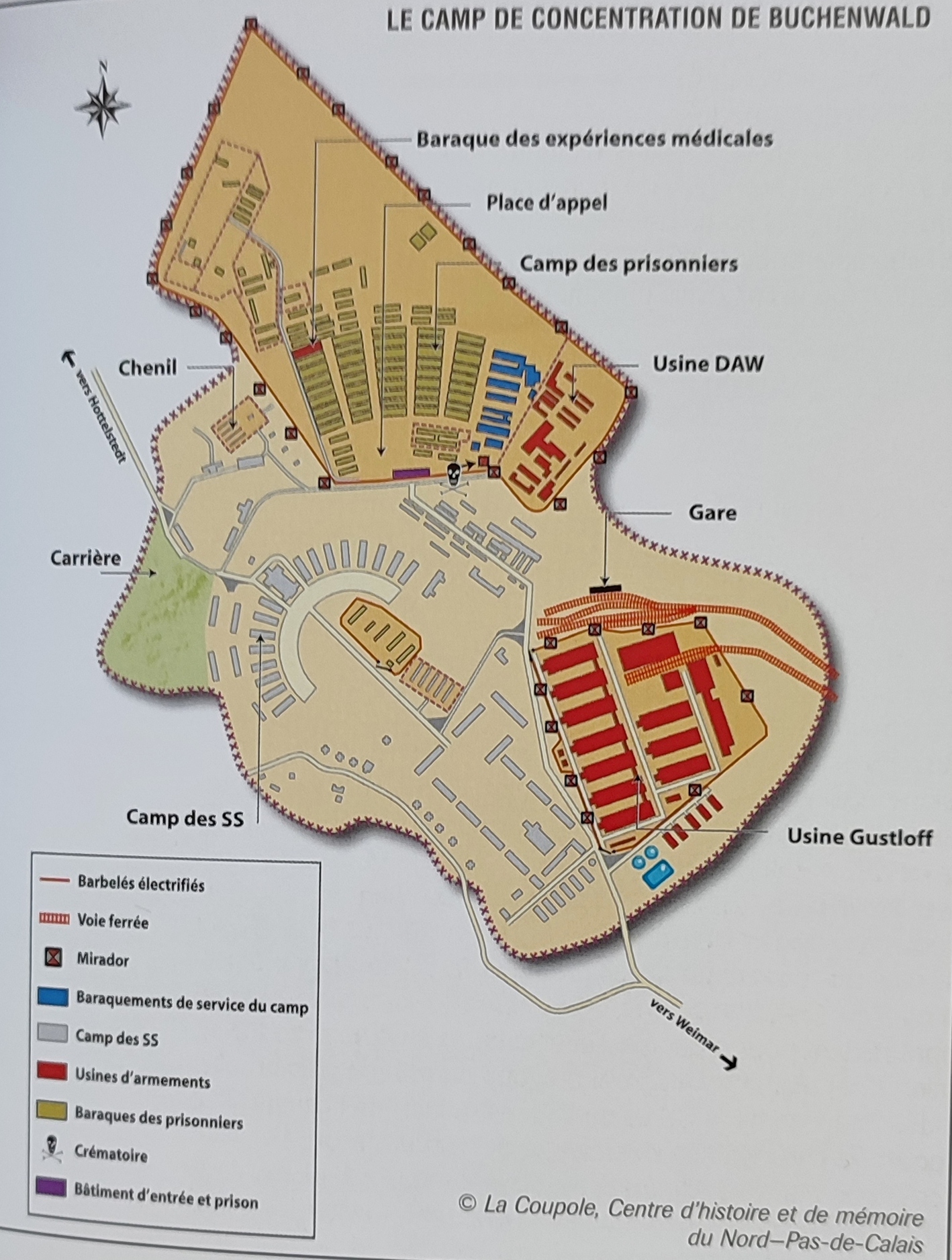
The prisoners
Until 1942, the majority of inmates were Germans, then Austrians, then Czechoslovakians, political opponents, homosexuals, Jehovah’s Witnesses, Gypsies, Jews (particularly after Kristallnacht in November 1938), priests and pastors, before the latter were grouped together in the Dachau camp.
After the invasion of the USSR from June 22, 1941 to February 1942 (Operation Barbarossa), many Soviet prisoners of war were executed in the camp.
From 1942 onwards, political opponents from all occupied countries arrived.
The first Frenchmen were voluntary workers in Germany, then workers under the Relève and STO (Service du Travail Obligatoire) schemes. In 1943, the first French political deportees arrived, including miners from Lorraine and Nord-Pas-de-Calais, who were transferred to Dora.
Of all the concentration camps, Buchenwald took in the highest number of French nationals, around 30,000, out of a total inmate population of 239,000.
In addition to this population of deportees, there were a number of personalities of « high rank » or « honor », such as Paul Reynaud, Léon Blum (authorized to marry in Buchenwald on October 8, 1943), Georges Mandel (brought back to France in July 1944 and murdered by the Milice in France), Princess Mafalda of Hesse (daughter of Italian King Victor Emmanuel III) killed during the bombing of the camp on August 25, 1944. They were housed outside the camp.
A quarantine camp, known as « petit camp », (blocks 51 to 66), through which all prisoners passed while awaiting assignment. In the summer of 1944, three huge tents capable of housing 1,000 inmates were erected to cope with the influx of deportees. In January 1945, thousands of prisoners evacuated from Auschwitz were housed here. The number of orphaned children was so great that they were grouped together in a single block n°66. Their living conditions were improved thanks to the resistance of the political prisoners.
Medical experiments
Research » was carried out on typhus, cholera, malaria, diphtheria, smallpox, poisons and nutrition…
In Block 61, many prisoners were killed by benzene injections as soon as they arrived at the camp. As in the Sachsenhausen camp, prisoners were shot in the back of the head. In the Bunker, prisoners are tortured, hanged and executed.
The Kommandos
More than 130 kommandos provided the labor needed for the camp (cooking, maintenance…), SS workshops, central German industries: IG Farben, Heinkel, Junker, Siebl, BMW… and from 1942, for the arms industry in underground factories kept secret.
The main ones are located in :
– Harzungen
– Neu Strassfurt: galleries built in former salt mines for weapons production workshops;
– Osterhagen: disciplinary Kommando, salt and potash mines;
– Dora: opened in September 1943, this camp became autonomous on October 28, 1944 under the name of Mittelbau-Dora;
– Leipzig-Thekla: for the Erla Maschinenwerk Gmbh factory;
– Hasag-Leipzig brought together 3,000 women (including 300 French women) who had come from Ravensbrück in July 1944 to rebuild a factory bombed by the RAF, then employed to manufacture shells and grenade launchers.
Ohrdruf: initially an autonomous camp, SIII, under the SS, then a Buchenwald Kommando. Prisoners, many of them Jews, dug tunnels to build one of Hitler’s secret HQs. Few of the 26,000 inmates survived. Ohrdruf, where Bach played the organ and harpsichord as a schoolboy, was one of the worst Kommandos in the entire Reich. Forgotten today, its name was better known than that of Auschwitz at the Liberation: on April 12, 1945, American General Eisenhower, flanked by Generals Bradley and Patton, forced German civilians to walk past the 3,200 abandoned corpses and bury them. The photos and Eisenhower’s words were picked up by the international media : « We’re told that the American soldier doesn’t know what he’s fighting for. Now, at least, he’ll know what he’s fighting against… It has to be known. We can’t remain silent in the face of such a tragedy.
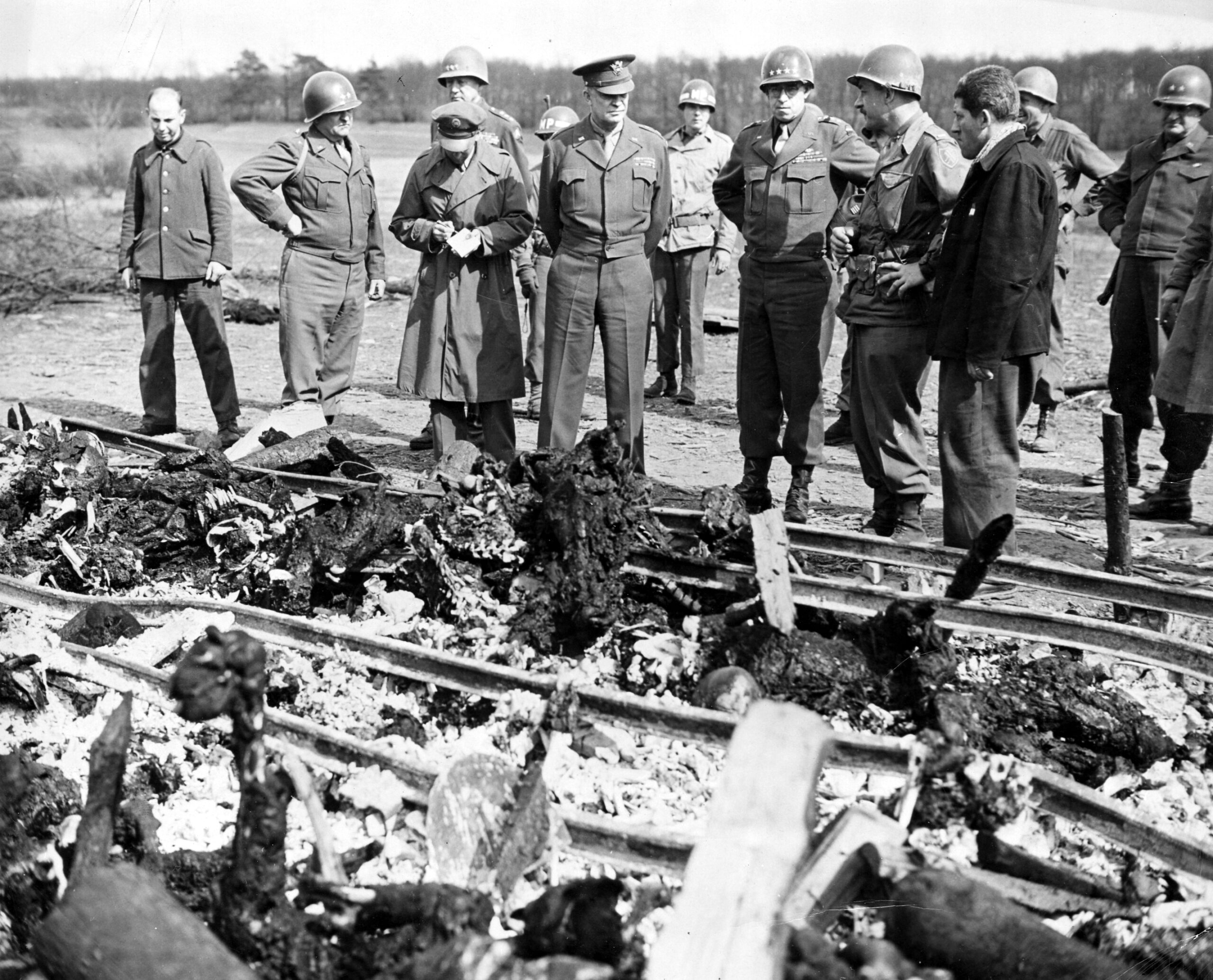
© US Army
The bombing of August 25, 1944
At 11:30 a.m., an Allied air raid bombed the camp’s factories, where weapons and guidance systems for the V2 rockets were manufactured. These were largely destroyed, as were a number of SS barracks and villas.
The « Goethe oak », as it was called by the deportees, was burnt and then felled. Only the stump remained. Symbolically, the destruction of the oak signified the imminent end of the Third Reich.
Intellectual life
Within the camp, cultural life was intense: conferences, creation of drawings, poems, metal engravings, such as the lighter by engraver Pierre Provost or drawings by painter Boris Taslitzky :

© Lutetia.info

La dépression
© Musée de la Résistance nationale
Resistance
The resistance was very active, as the camp organization was run not by « common law » prisoners, but since 1942 by German « politicians », the first inmates.
The French were grouped around two personalities who headed the « Comité des Intérêts Français » (CIF):
Colonel Frédéric-Henri Manhès, Jean Moulin’s representative in the northern zone, arrested by the Gestapo, deported from France on January 22, 1944, and future Companion of the Liberation.
Marcel Paul, trade unionist, communist activist, deported from France on April 27, 1944 to Auschwitz in the convoy known as « Les Tatoués », transferred to Buchenwald on May 14, 1944.
The CIF took part in the camp’s « International Clandestine Committee », which enabled international resistance: information on the advance of the Allied armies, solidarity, culture, care, rescue of prisoners directly threatened with death by the SS, sabotage of war industry, preparations for a liberation insurrection.
Buchenwald’s oath
In April 1945, the SS wanted to evacuate 48,000 prisoners. The Committee opposed this mass departure: 25,000 were sent to Dachau and Theresiendstadt. The rest remained in Buchenwald.
On April 11, the camp’s SS garrison, reinforced by fresh troops, fought against the approaching American troops. Inside the camp, the underground resistance got rid of the guard troops and took control of the camp. By the time general Patton arrived with his tanks, the camp was in the hands of the International Committee on April 13.
On April 19, 1945, on the roll-call square, the survivors write and pronounce « THE BUCHENWALD SERMENT »:
« One thought animates us: OUR CAUSE IS JUST, VICTORY WILL BE OURS.
In many languages, we have fought the same hard and merciless battle. It has claimed many victims, and it is not yet over. The flags are still flying and the killers of our comrades are still alive. Our sadistic torturers are still at large. That’s why we swear, on these sites of fascist crimes, before the whole world, that we will only give up the struggle when the last of those responsible is condemned before the tribunal of all Nations. The definitive crushing of Nazism is our task.
OUR IDEAL IS TO BUILD A NEW WORLD IN PEACE AND FREEDOM. We owe it to our slain comrades and their families. Raise your hands and swear that you are ready to fight.
The « Buchenwald children » protected by the International Committee attend the Oath.
The French government commissioned the OSE (Œuvre de Secours aux Enfants) to repatriate 427 of them and house them in « foyers-maisons » in the Paris region. Elie Wiesel, future Nobel Peace Prize winner, was one of them.
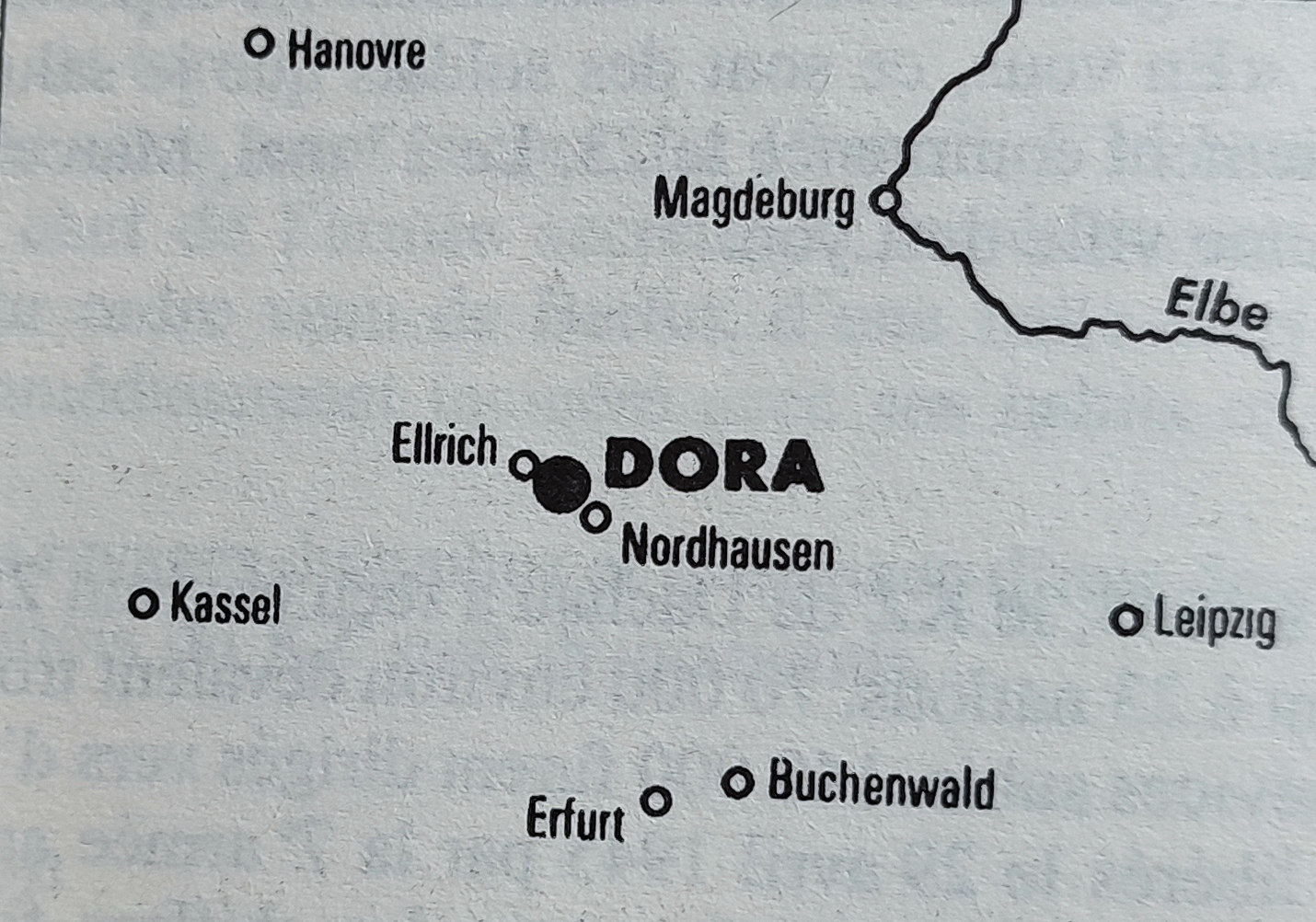
© FNDIRP
Mittelbau-Dora
When it opened in 1943, the Dora camp was a Kommando of the Buchenwald camp, located in the Harz hills of Thuringia, between the towns of Ellrich and Nordhausen.
Since the 1930s, the Nazis had been researching new weapons.
In 1936, a research base was built at Peenemünde on the Baltic Sea, both a manufacturing center and a missile testing facility. On August 17 and 18, 1943, the Royal Air Force bombed and destroyed this center. It was immediately decided to move it to an underground site in Kohnstein, near the town of Nordhausen. The site already existed, tunnels having been dug to extract gypsum and store chemicals and fuel. The tunnels were converted so that the Mittelwerk factory could produce and assemble much-needed rockets.
The first prisoners arrived on August 28, 1943, to empty the tunnels, complete the construction of the two tunnels A and B (L= 1,800 m, l= 12.5 m, h= 9 m), link them by 46 cross galleries 180 m long, and build an outdoor camp for the SS.
All European opponents were represented: Germans, French, Czechoslovaks, Russians, Yugoslavs, Ukrainians, Poles, Spaniards, Italians, Belgians and Hungarian Jews.
The inmates work and live underground. The noise, the smell, the humidity, the lack of drinking water and hygiene were the causes of a very high mortality rate. 6,000 deportees died in the first 8 months.
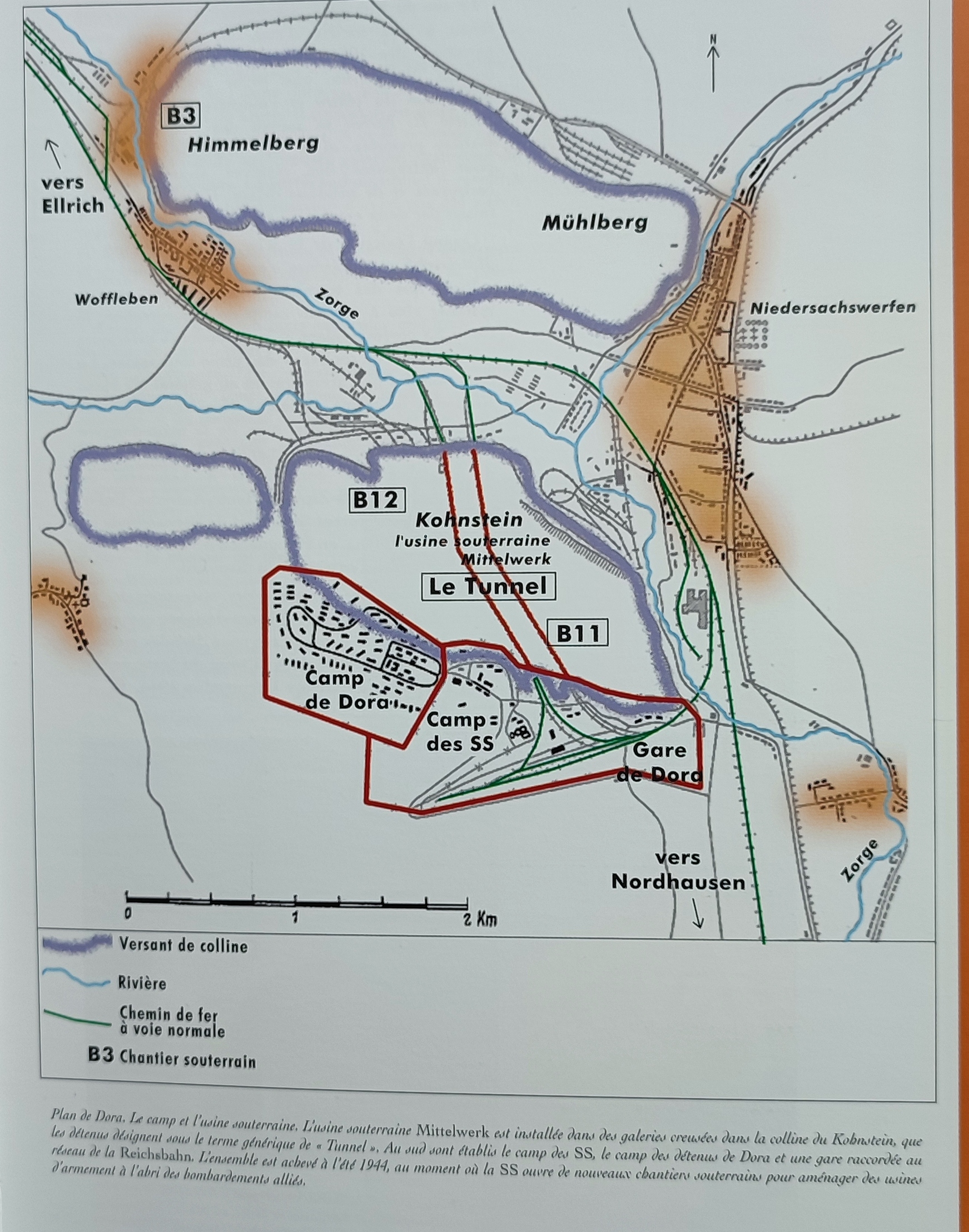
Plan du camp de Dora
The « black transports »: In early 1944, sick prisoners who could no longer work were sent to « rest camps » at Majdanek near Lublin. In reality, this was a HimmelKommando (« sky Kommando ») from which no one would ever return.
On October 28, 1944, Mittelbau-Dora became an independent camp of Buchenwald, with 32 Kommandos.
In kommandos such as Ellrich, Harzungen, Blankenburg, Langenstein and Neu Strassfurt, inmates worked for the war industry. In addition, there were Kommandos belonging to other camps, such as Leitmeritz and Hersbruck associated with Flossenbürg, Ebensee and Gusen associated with Mauthausen, and the Neckar camps belonging to Natzweiler-Struthof.
Mortality rises as massive convoys arrive from Auschwitz in early 1945.
Evacuation of the camp
At the beginning of April 1945, the SS decided to empty the camp and its Kommandos. Prisoners were evacuated northwards in what came to be known as the « death marches », to the camps of Bergen-Belsen, Neuengamme, Sachsenhausen and Ravensbrück.
As a column of deportees approached Gardelegen, near Magdeburg, on April 13, they were herded into a barn by SS Erhard Brauny, who set it on fire.
1,016 dead, burned alive.
The next day, the murderers dug trenches to bury the dead and hide their crime, but the American army arrived in time to force the population to bury the victims individually. SS Brauny was tried and sentenced to life imprisonment.
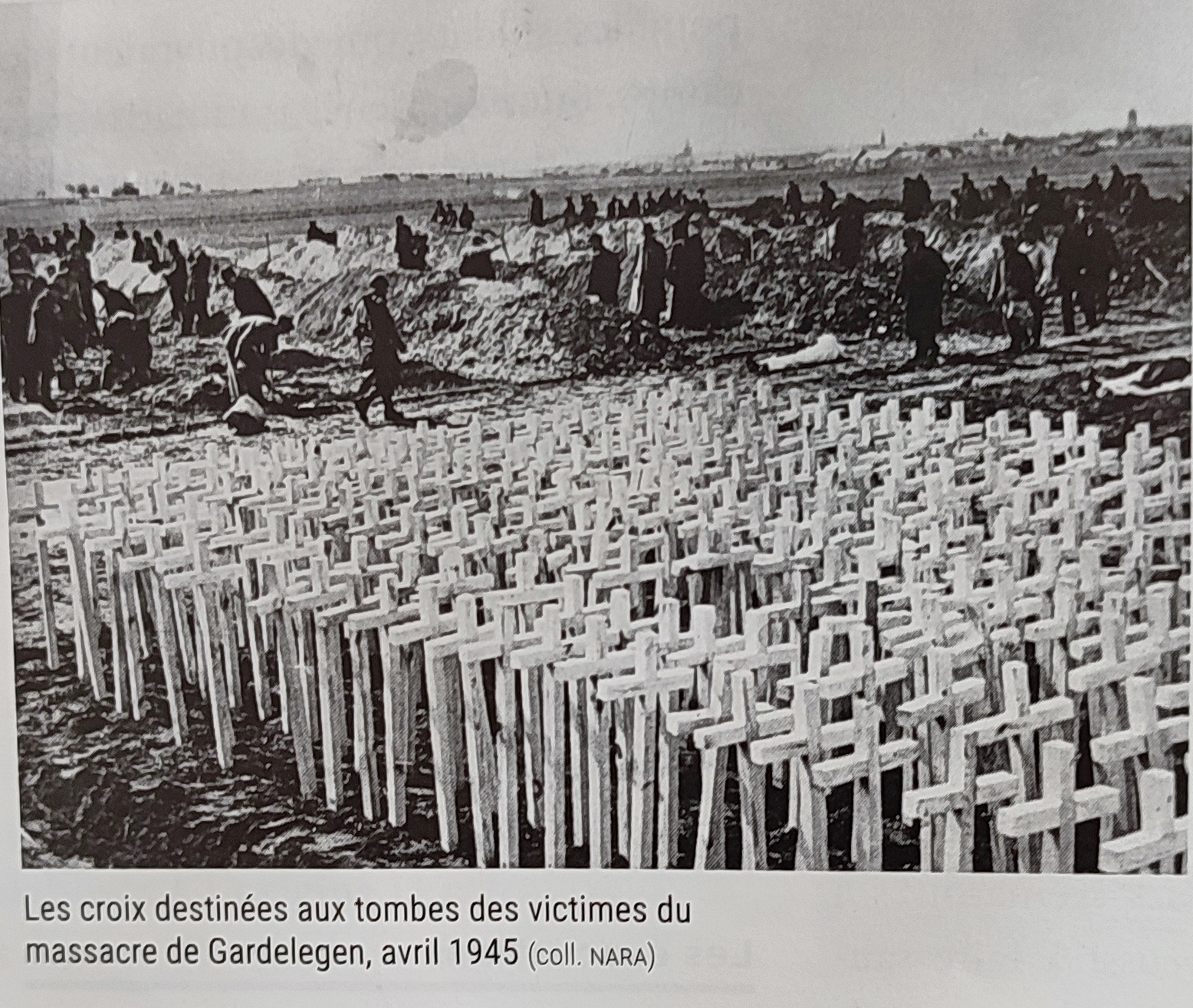
© Coll. Nara
Liberation
The camp was liberated on April 11, 1945 by the US 9th Army.
When the camp is liberated, Wernher Von Braun, the SS aeronautical engineer, surrenders to the Allies. The Americans recovered the plans and files for the construction of the V1 and V2 rockets. Along with 1,500 German scientists, Von Braun was exfiltrated to the United States during Operation Paperclip. He continued to work for NASA, becoming an American citizen in 1955. A « hero » of the conquest of space, he was never brought to trial.
9,000 prisoners were deported from France; 1/3 of them did not survive.
Sources
https://asso-buchenwald-dora.com
https://asso-buchenwald-dora.com/le-kommando-de-ganderscheim/
https://www.jewishgen.org/forgottencamps/witnesses/nickolsfr.html
https://museedelaresistanceenligne.org/media6386-Liste-de-dports-transfrs-de-Buchenwald-au-kommando-de-Gandersheim
https://fr.wikipedia.org/wiki/Liste_des_Kommandos_de_Buchenwald_Dora
https://www.amicale-deportes-stassfurt.com/
ANTELME Robert, L’espèce humaine, written in 1947, ed. Gallimard, coll. Tel, 1978
Edgar Morin: « Many accounts by deportees are theoretical, written in a stereotyped language. […] L’espèce humaine was the first, I would even say the only book that was at the level of humanity, at the level of naked experience, lived and expressed in the simplest and most appropriate words… […] for me, the book that speaks at this level of existence, of experience, and devoid of any personalized feeling of hatred, of any pettiness, of course of any injustice, for me remains L’espèce humaine. »
BLATMAN Daniel, Les Marches de la mort, La dernière étape du génocide nazi 1944-1945, ed. Fayard, 2009.
Cercle d’étude de la Déportation et de la Shoah-Amicale d’Auschwitz, Les Marches et Trains de la mort, June 2016.
DURAND Pierre, La Résistance des français à Buchenwald et à Dora, Editions sociales, 1982, republished in 2020, ed. Delga.
KERTÈSZ Imre, Être sans destin, Actes Sud, 1997, translated from Hungarian by Charles Zaremba and Natalia Zaremba-Huzsvai, winner of the Nobel Prize for Literature in 2002.
Mémoire vivante, bulletin of the Fondation pour la Mémoire de la Déportation, Buchenwald, n°35, Oct. 2002 and Dora, n°48, Dec. 2005.
Le Serment, bulletin of the Association Buchenwald-Dora et Kommandos: special issue « Cinquantenaire de la Libération », 1995 and supplement to n°379: special issue for the 75th anniversary 1945-2020, edited by Dominique DURAND.
LALIEU Olivier, La Zone grise? La Résistance française à Buchenwald, preface by Jorge Semprun, ed. Taillandier, 2005.
ORLOWSKI Dominique (ed.), Buchenwald par ses témoins – Histoire du camp et ses kommandos, preface by Bertrand Herz, ed. Belin, 2014.
THIERCELIN Jean-Pierre, De l’enfer à la lune, play, éd. de l’Amandier, 2006.
Sous la direction de Laurent THIERY, Le livre des 9 000 déportés de France à Mittelbau-Dora, camp de concentration et d’extermination par le travail, preface by Aurélie Filippetti, ed. Cherche Midi, 2000.
SEMPRUN Jorge, Le grand voyage, Collection Blanche, ed. Gallimard, 1963.
TASLITZKY Boris, Cent-onze dessins faits à Buchenwald, rassembés par l’Association Buchenwald- Dora, ed. Hautefeuille, 1978
Buchenwald
Opened in 1937

© Vincent Gerbet
Monument’s description
Inaugurated on April 5, 1964, the bronze sculpture by Louis Bancel (Vercors resistance fighter), installed on a granite slab by architect M. Romer (Buchenwald survivor), features a group of three deportees. The emaciation of the three men testifies to the physical decline of the concentration camp system. The attitude of each of the deportees evokes a precise symbolism: suffering (man upside down, frozen in death, hand hanging down), solidarity (man supporting his companion), resistance and dignity (man standing up to his executioners, head proudly raised towards the future).
On the edge of the slab is engraved: Buchenwald-Dora. And on the slab:
May this forever show how
Man had to fall and how
Courage and devotion
preserve his name of Man.
Louis Aragon
Poet Louis Aragon’s quatrain underlines the courage in martyrdom of all those who, with dignity, opposed the dehumanization of Nazi ideology.
Buchenwald camp

© FNDIRP
In 1937, it was decided to build the Buchenwald camp on the wooded Ettersberg hill in Thuringia, 10 km from Weimar, a city famous for its cultural influence (Goethe, Schiller, Bach) and for having given its name to the Weimar Republic from 1918 to 1933.
The aim was to provide manpower for the industries of central Germany.
Common law prisoners from Sachsenhausen, Lichtenburg and Sachsenburg, known as « green triangles », cleared the Buchenwald hill (meaning « beech forest »), sparing the large oak under whose shade, according to legend, Goethe would go to rest with his secretary.
Everything was created: earthworks, electrification, water supply, roads and a railway station. A nearby quarry facilitated logistics. The inscription JEDEM DAS SEINE « To each his own » hangs over the entrance gate.

©AFMD 75
The camp comprises three areas:
– one reserved for prisoners (roll-call area, prisoners’ blocks, canteen, Revier… but also a « station » for medical experiments, executions and crematoria built in 1941.
– one reserved for the SS (Kommandur, administration, 18 barracks, officers’ residential quarters, military hospital, zoo, stables, farm, library),
– another for factories and workshops: the D.A.W. (Deutsche Ausrüstungs Werke) and the Gustloff Werke arms factory.
Translated with DeepL.com (free version)

The prisoners
Until 1942, the majority of inmates were Germans, then Austrians, then Czechoslovakians, political opponents, homosexuals, Jehovah’s Witnesses, Gypsies, Jews (particularly after Kristallnacht in November 1938), priests and pastors, before the latter were grouped together in the Dachau camp.
After the invasion of the USSR from June 22, 1941 to February 1942 (Operation Barbarossa), many Soviet prisoners of war were executed in the camp.
From 1942 onwards, political opponents from all occupied countries arrived.
The first Frenchmen were voluntary workers in Germany, then workers under the Relève and STO (Service du Travail Obligatoire) schemes. In 1943, the first French political deportees arrived, including miners from Lorraine and Nord-Pas-de-Calais, who were transferred to Dora.
Of all the concentration camps, Buchenwald took in the highest number of French nationals, around 30,000, out of a total inmate population of 239,000.
In addition to this population of deportees, there were a number of personalities of « high rank » or « honor », such as Paul Reynaud, Léon Blum (authorized to marry in Buchenwald on October 8, 1943), Georges Mandel (brought back to France in July 1944 and murdered by the Milice in France), Princess Mafalda of Hesse (daughter of Italian King Victor Emmanuel III) killed during the bombing of the camp on August 25, 1944. They were housed outside the camp.
A quarantine camp, known as « petit camp », (blocks 51 to 66), through which all prisoners passed while awaiting assignment. In the summer of 1944, three huge tents capable of housing 1,000 inmates were erected to cope with the influx of deportees. In January 1945, thousands of prisoners evacuated from Auschwitz were housed here. The number of orphaned children was so great that they were grouped together in a single block n°66. Their living conditions were improved thanks to the resistance of the political prisoners.
Medical experiments
Research » was carried out on typhus, cholera, malaria, diphtheria, smallpox, poisons and nutrition…
In Block 61, many prisoners were killed by benzene injections as soon as they arrived at the camp. As in the Sachsenhausen camp, prisoners were shot in the back of the head. In the Bunker, prisoners are tortured, hanged and executed.
The Kommandos
More than 130 kommandos provided the labor needed for the camp (cooking, maintenance…), SS workshops, central German industries: IG Farben, Heinkel, Junker, Siebl, BMW… and from 1942, for the arms industry in underground factories kept secret.
The main ones are located in :
– Harzungen
– Neu Strassfurt: galleries built in former salt mines for weapons production workshops;
– Osterhagen: disciplinary Kommando, salt and potash mines;
– Dora: opened in September 1943, this camp became autonomous on October 28, 1944 under the name of Mittelbau-Dora;
– Leipzig-Thekla: for the Erla Maschinenwerk Gmbh factory;
– Hasag-Leipzig brought together 3,000 women (including 300 French women) who had come from Ravensbrück in July 1944 to rebuild a factory bombed by the RAF, then employed to manufacture shells and grenade launchers.
Ohrdruf: initially an autonomous camp, SIII, under the SS, then a Buchenwald Kommando. Prisoners, many of them Jews, dug tunnels to build one of Hitler’s secret HQs. Few of the 26,000 inmates survived. Ohrdruf, where Bach played the organ and harpsichord as a schoolboy, was one of the worst Kommandos in the entire Reich. Forgotten today, its name was better known than that of Auschwitz at the Liberation: on April 12, 1945, American General Eisenhower, flanked by Generals Bradley and Patton, forced German civilians to walk past the 3,200 abandoned corpses and bury them. The photos and Eisenhower’s words were picked up by the international media : « We’re told that the American soldier doesn’t know what he’s fighting for. Now, at least, he’ll know what he’s fighting against… It has to be known. We can’t remain silent in the face of such a tragedy.

© US Army
The bombing of August 25, 1944
At 11:30 a.m., an Allied air raid bombed the camp’s factories, where weapons and guidance systems for the V2 rockets were manufactured. These were largely destroyed, as were a number of SS barracks and villas.
The « Goethe oak », as it was called by the deportees, was burnt and then felled. Only the stump remained. Symbolically, the destruction of the oak signified the imminent end of the Third Reich.
Intellectual life
Within the camp, cultural life was intense: conferences, creation of drawings, poems, metal engravings, such as the lighter by engraver Pierre Provost or drawings by painter Boris Taslitzky :

© Lutetia.info

La dépression
© Musée de la Résistance nationale
Resistance
The resistance was very active, as the camp organization was run not by « common law » prisoners, but since 1942 by German « politicians », the first inmates.
The French were grouped around two personalities who headed the « Comité des Intérêts Français » (CIF):
Colonel Frédéric-Henri Manhès, Jean Moulin’s representative in the northern zone, arrested by the Gestapo, deported from France on January 22, 1944, and future Companion of the Liberation.
Marcel Paul, trade unionist, communist activist, deported from France on April 27, 1944 to Auschwitz in the convoy known as « Les Tatoués », transferred to Buchenwald on May 14, 1944.
The CIF took part in the camp’s « International Clandestine Committee », which enabled international resistance: information on the advance of the Allied armies, solidarity, culture, care, rescue of prisoners directly threatened with death by the SS, sabotage of war industry, preparations for a liberation insurrection.
Buchenwald’s oath
In April 1945, the SS wanted to evacuate 48,000 prisoners. The Committee opposed this mass departure: 25,000 were sent to Dachau and Theresiendstadt. The rest remained in Buchenwald.
On April 11, the camp’s SS garrison, reinforced by fresh troops, fought against the approaching American troops. Inside the camp, the underground resistance got rid of the guard troops and took control of the camp. By the time general Patton arrived with his tanks, the camp was in the hands of the International Committee on April 13.
On April 19, 1945, on the roll-call square, the survivors write and pronounce « THE BUCHENWALD SERMENT »:
« One thought animates us: OUR CAUSE IS JUST, VICTORY WILL BE OURS.
In many languages, we have fought the same hard and merciless battle. It has claimed many victims, and it is not yet over. The flags are still flying and the killers of our comrades are still alive. Our sadistic torturers are still at large. That’s why we swear, on these sites of fascist crimes, before the whole world, that we will only give up the struggle when the last of those responsible is condemned before the tribunal of all Nations. The definitive crushing of Nazism is our task.
OUR IDEAL IS TO BUILD A NEW WORLD IN PEACE AND FREEDOM. We owe it to our slain comrades and their families. Raise your hands and swear that you are ready to fight.
The « Buchenwald children » protected by the International Committee attend the Oath.
The French government commissioned the OSE (Œuvre de Secours aux Enfants) to repatriate 427 of them and house them in « foyers-maisons » in the Paris region. Elie Wiesel, future Nobel Peace Prize winner, was one of them.

© FNDIRP
Mittelbau-Dora
When it opened in 1943, the Dora camp was a Kommando of the Buchenwald camp, located in the Harz hills of Thuringia, between the towns of Ellrich and Nordhausen.
Since the 1930s, the Nazis had been researching new weapons.
In 1936, a research base was built at Peenemünde on the Baltic Sea, both a manufacturing center and a missile testing facility. On August 17 and 18, 1943, the Royal Air Force bombed and destroyed this center. It was immediately decided to move it to an underground site in Kohnstein, near the town of Nordhausen. The site already existed, tunnels having been dug to extract gypsum and store chemicals and fuel. The tunnels were converted so that the Mittelwerk factory could produce and assemble much-needed rockets.
The first prisoners arrived on August 28, 1943, to empty the tunnels, complete the construction of the two tunnels A and B (L= 1,800 m, l= 12.5 m, h= 9 m), link them by 46 cross galleries 180 m long, and build an outdoor camp for the SS.
All European opponents were represented: Germans, French, Czechoslovaks, Russians, Yugoslavs, Ukrainians, Poles, Spaniards, Italians, Belgians and Hungarian Jews.
The inmates work and live underground. The noise, the smell, the humidity, the lack of drinking water and hygiene were the causes of a very high mortality rate. 6,000 deportees died in the first 8 months.

Plan du camp de Dora
The « black transports »: In early 1944, sick prisoners who could no longer work were sent to « rest camps » at Maïdanek near Lublin. In reality, this was a HimmelKommando (« sky Kommando ») from which no one would ever return.
On October 28, 1944, Mittelbau-Dora became an independent camp of Buchenwald, with 32 Kommandos.
In kommandos such as Ellrich, Harzungen, Blankenburg, Langenstein and Neu Strassfurt, inmates worked for the war industry. In addition, there were Kommandos belonging to other camps, such as Leitmeritz and Hersbruck associated with Flossenbürg, Ebensee and Gusen associated with Mauthausen, and the Neckar camps belonging to Natzweiler-Struthof.
Mortality rises as massive convoys arrive from Auschwitz in early 1945.
Evacuation of the camp
At the beginning of April 1945, the SS decided to empty the camp and its Kommandos. Prisoners were evacuated northwards in what came to be known as the « death marches », to the camps of Bergen-Belsen, Neuengamme, Sachsenhausen and Ravensbrück.
As a column of deportees approached Gardelegen, near Magdeburg, on April 13, they were herded into a barn by SS Erhard Brauny, who set it on fire.
1,016 dead, burned alive.
The next day, the murderers dug trenches to bury the dead and hide their crime, but the American army arrived in time to force the population to bury the victims individually. SS Brauny was tried and sentenced to life imprisonment.

© Coll. Nara
Liberation
The camp was liberated on April 11, 1945 by the US 9th Army.
When the camp is liberated, Wernher Von Braun, the SS aeronautical engineer, surrenders to the Allies. The Americans recovered the plans and files for the construction of the V1 and V2 rockets. Along with 1,500 German scientists, Von Braun was exfiltrated to the United States during Operation Paperclip. He continued to work for NASA, becoming an American citizen in 1955. A « hero » of the conquest of space, he was never brought to trial.
9,000 prisoners were deported from France; 1/3 of them did not survive.
Sources
https://asso-buchenwald-dora.com
https://asso-buchenwald-dora.com/le-kommando-de-ganderscheim/
https://www.jewishgen.org/forgottencamps/witnesses/nickolsfr.html
https://museedelaresistanceenligne.org/media6386-Liste-de-dports-transfrs-de-Buchenwald-au- kommando-de-Gandersheim
https://fr.wikipedia.org/wiki/Liste_des_Kommandos_de_Buchenwald_Dora
https://www.amicale-deportes-stassfurt.com/
ANTELME Robert, L’espèce humaine, written in 1947, ed. Gallimard, coll. Tel, 1978
Edgar Morin: « Many accounts by deportees are theoretical, written in a stereotyped language. […] L’espèce humaine was the first, I would even say the only book that was at the level of humanity, at the level of naked experience, lived and expressed in the simplest and most appropriate words… […] for me, the book that speaks at this level of existence, of experience, and devoid of any personalized feeling of hatred, of any pettiness, of course of any injustice, for me remains L’espèce humaine. »
BLATMAN Daniel, Les Marches de la mort, La dernière étape du génocide nazi 1944-1945, ed. Fayard, 2009.
Cercle d’étude de la Déportation et de la Shoah-Amicale d’Auschwitz, Les Marches et Trains de la mort, June 2016.
DURAND Pierre, La Résistance des français à Buchenwald et à Dora, Editions sociales, 1982, republished in 2020, ed. Delga.
KERTÈSZ Imre, Être sans destin, Actes Sud, 1997, translated from Hungarian by Charles Zaremba and Natalia Zaremba-Huzsvai, winner of the Nobel Prize for Literature in 2002.
Mémoire vivante, bulletin of the Fondation pour la Mémoire de la Déportation, Buchenwald, n°35, Oct. 2002 and Dora, n°48, Dec. 2005.
Le Serment, bulletin of the Association Buchenwald-Dora et Kommandos: special issue « Cinquantenaire de la Libération », 1995 and supplement to n°379: special issue for the 75th anniversary 1945-2020, edited by Dominique DURAND.
LALIEU Olivier, La Zone grise? La Résistance française à Buchenwald, preface by Jorge Semprun, ed. Taillandier, 2005.
ORLOWSKI Dominique (ed.), Buchenwald par ses témoins – Histoire du camp et ses kommandos, preface by Bertrand Herz, ed. Belin, 2014.
THIERCELIN Jean-Pierre, De l’enfer à la lune, play, éd. de l’Amandier, 2006.
Sous la direction de Laurent THIERY, Le livre des 9 000 déportés de France à Mittelbau-Dora, camp de concentration et d’extermination par le travail, preface by Aurélie Filippetti, ed. Cherche Midi, 2000.
SEMPRUN Jorge, Le grand voyage, Collection Blanche, ed. Gallimard, 1963.
TASLITZKY Boris, Cent-onze dessins faits à Buchenwald, rassembés par l’Association Buchenwald- Dora, ed. Hautefeuille, 1978
Délégation de Paris des Amis de la Fondation
pour la Mémoire de la Déportation
31 Boulevard Saint-Germain 75005 Paris
Contact : afmd.dt75@gmail.com
©AFMD75




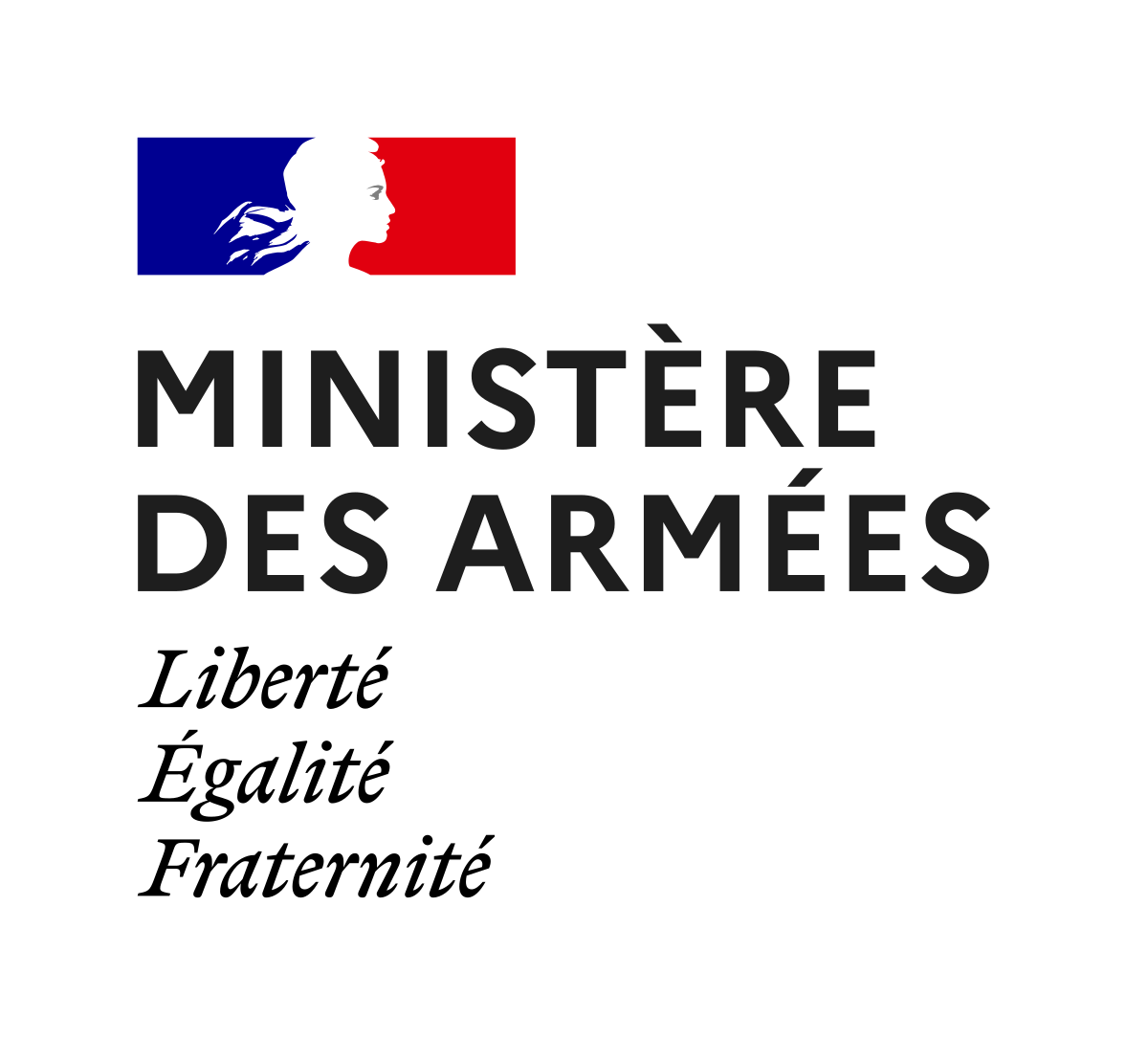
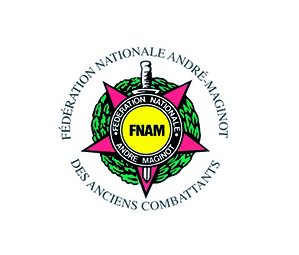
Délégation de Paris
des Amis de la Fondation
pour la Mémoire de la Déportation
31 Boulevard Saint-Germain
75005 Paris
Contact :
afmd75@gmail.com
©AFMD75
Délégation de Paris
des Amis de la Fondation
pour la Mémoire
de la Déportation
31 Boulevard Saint-Germain
75005 Paris
Contact
afmd75@gmail.com
©AFMD75

